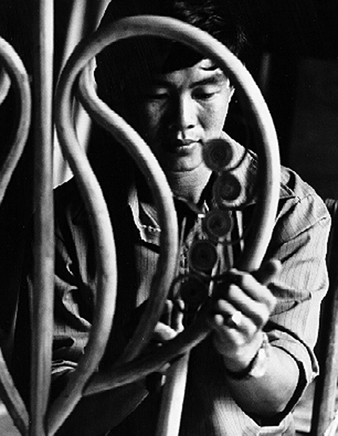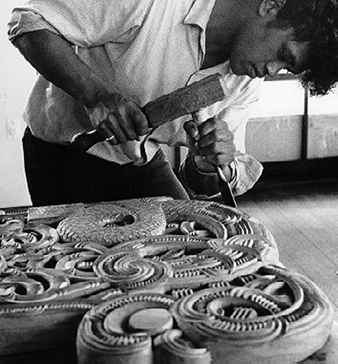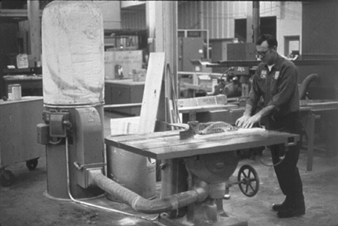Woodworking is practised as an art form and utilitarian craft all over the world. It includes wood sculpture, furniture and cabinet making (figure 1), musical instrument making and so on. Techniques include carving (figure 2), laminating, joining, sawing, sanding, paint removing, painting and finishing. Woodworking uses a large number of different types of hard and soft woods, including many exotic tropical woods, plywood and composition boards, and sometimes woods treated with pesticides and wood preservatives.
Figure 1. Furniture making.
Figure 2. Carving wood with hand tools.
Hazards and Precautions
Woods
Many woods are hazardous, especially tropical hardwoods. Types of reactions can include skin allergies and irritation from the sap, wood dust or sometimes the wood, as well as conjunctivitis, respiratory allergies, hypersensitivity pneumonia and toxic reactions. Inhalation of hardwood dust is associated with a particular type of nasal and nasal sinus cancer (adenocarcinoma). See the chapter Woodworking industry.
Precautions include avoiding use of sensitizing woods for people who have a history of allergies, or for objects where people would be in frequent contact with the wood, and controlling dust levels by using local exhaust ventilation or wearing a toxic-dust respirator. When handling woods that can cause skin irritation or allergies, the artist should wear gloves or apply a barrier cream. Hands should be washed carefully after work.
Plywoods and composition board
Plywood and composition board (e.g., particle board) are made by gluing thin sheets of wood, or wood dust and chips, together with either urea-formaldehyde glues or phenol-formaldehyde glues. These materials can emit unreacted formaldehyde for some years after manufacture, with composition board emitting more formaldehyde. Heating these materials or machining them can cause decomposition of the glue to release formaldehyde. Formaldehyde is a skin, eye and respiratory irritant and strong sensitizer, and a probable human carcinogen.
Precautions include using low-formaldehyde products whenever possible, not storing large amounts of plywood or composition board in the shop, and using dust collectors connected to woodworking machines that are exhausted to the outside.
Wood preservatives and other treatments
Pesticides and preservatives are often applied to wood when it is being timbered, processed or shipped. Pentachlorophenol and its salts, creosote and chromated copper arsenate (CCA) have been banned for sale in the United States as wood preservatives because of possible carcinogenicity and reproductive hazards. They can, however, still be found in older woods, and chromated copper arsenate is still allowed as a commercial treatment (e.g., “green” lumber, playground equipment and other outdoor uses). A variety of other chemicals can be used in treating wood, including fire retardants and bleaches.
Precautions include not handling woods that have been treated with pentachlorophenol or creosote, using local exhaust ventilation when machining CCA-treated wood or wearing a respirator with high-efficiency filters. Wood that has been treated with creosote, pentachlorophenol or chromated copper arsenate should not be burned.
Carving and machining wood
Woods can be hand carved with chisels, rasps, hand saws, sandpaper and the like, or they can be machined with electric saws, sanders and other woodworking machines. Hazards include exposure to wood dusts, excessive noise levels from woodworking machines, accidents from using tools and machines, electrical shock or fire from faulty wiring, and wood fires. Vibrating tools—for example, chain saws—can cause “white fingers” (Raynaud’s phenomenon), involving numbness of the fingers and hands.
Precautions include equipping woodworking machines with dust collectors (figure 3) and machine guards, cleaning up sawdust to avoid fire hazards, wearing goggles (and sometimes face shields) and reducing noise. Using the appropriate machine for the desired operation, and repairing defective machines immediately; keeping hand tools sharpened, and using them safely; keeping all electrical equipment and wiring in good repair, and avoiding extension cords which can be tripped over; not wearing ties, long loose hair, loose sleeves or other items that could catch in machinery are some other precautions.
Figure 3. Woodworking machines with dust collector.
Michael McCann
Gluing wood
A variety of glues are used for laminating and joining wood, including contact adhesives, casein glue, epoxy glues, formaldehyde-resin glues, hide glues, white glue (polyvinyl acetate emulsion) and the cyanoacrylate “instant” glues. Many of these contain toxic solvents or other chemicals, and can be skin, eye and respiratory hazards.
Precautions include avoiding formaldehyde resin glues; using water-based glues rather then solvent-type glues; wearing gloves or barrier creams when using epoxy glues, solvent-based adhesives or formaldehyde-resin glues; and having good ventilation when using epoxy glues, cyanoacrylate glues and solvent-based glues. Sources of ignition should be avoided when using flammable solvents.
Painting and finishing
Wood can be painted with most types of paint; can be stained, lacquered or varnished; and can be treated with linseed or other types of oil. Other materials that are used in finishing wood include shellacs, polyurethane coatings and waxes. Many materials are sprayed. Some woodworkers mix their own paints from dry pigments. Hazards include inhalation of toxic pigment powder (especially lead chromate pigments), skin and inhalation hazards from solvents, fire hazards from flammable solvents, and spontaneous combustion from rags soaked with oil or turpentine.
Precautions include using ready-made paints rather than mixing your own; avoiding eating, drinking or smoking in the work area; using water-based paints rather than solvent-based ones; and placing oil- and solvent-soaked rags in self-closing oily-waste cans, or even a pail of water.
Precautions with solvents include wearing gloves and goggles, as well as having adequate ventilation; doing the operation outside; or wearing a respirator with organic vapour cartridges. Materials should be brushed on whenever possible, to avoid the hazards of spraying. Spraying finishes inside an explosion-proof spray booth, or wearing a respirator with organic vapour cartridges and spray filters; avoiding open flames, lit cigarettes and other sources of ignition (e.g., lit pilot lights) in the area when applying flammable finishes, or when spraying, are other precautions to be taken.
Paint stripping
Stripping old paint and varnish from wood and furniture is done with paint and varnish removers containing a wide variety of toxic and often flammable solvents. “Non-flammable” paint strippers contain methylene chloride. Caustic soda (sodium hydroxide), acids, blowtorches and heat guns are also used to remove old paint. Old stains on wood are often removed with bleaches, which can contain corrosive alkalis and oxalic acid, hydrogen peroxide or hypochlorite. Heat guns and torches can vaporize the paint, possibly causing lead poisoning with lead-based paint, and are a fire hazard.
See the previous section for precautions with solvent-based paint strippers. Gloves and goggles should be worn when handling caustic soda, oxalic acid bleaches or chlorine-type bleaches. An eyewash fountain and emergency shower should be available. Avoid using torches or heat guns to remove lead-containing paint.



